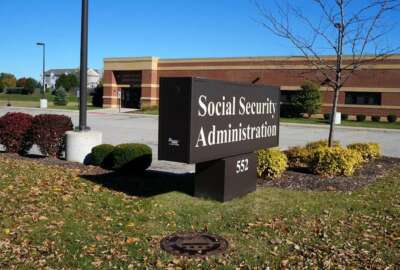 First Look
First Look Senators growing frustrated with SSA’s closed offices, pandemic workarounds
The Social Security Administration said it would begin to incrementally bring more staff back to work in person at its field offices, as senators say the workar...
Congress is looking for more answers from the Social Security Administration, and senators are growing frustrated with the workarounds the agency implemented during the pandemic in an effort to keep employees and the public safe.
SSA field and local offices have been closed since the start of the pandemic, though members of the public can make an appointment with the agency for “dire-need” requests.
But senators said members of the public, especially those from vulnerable populations who lack a sound internet connection or don’t have a reliable phone number or mailing address, are struggling to access SSA while field offices are largely closed.
“The employees at Social Security have worked hard to get payments out on time while undergoing big changes to the way the agency operates,” Ron Wyden (D-Ore.), chairman of the Senate Finance Committee, said Thursday at a hearing on SSA’s operations during the pandemic. “Despite that, the reality is social distancing and Social Security go together like water and oil.”
SSA managers have been working out of the field and local offices during the pandemic, and some employees have joined them. About 3,000 SSA managers and managers are working at field offices across the country today, said Grace Kim, the agency’s deputy commissioner for operations.
Those who are working at the offices are handling dire-need appointments with members of the public and are scanning 1.5 million pieces of mail and other documents into the agency’s systems each week.
Scanning these documents allows SSA employees to continue working from home, but it ultimately reduces productivity, Kim said.
In a lengthy letter to Congress ahead of Thursday’s hearing, SSA Commissioner Andrew Saul said it took the agency’s field offices 20% longer to complete actions in fiscal 2020. The workarounds they created for the pandemic “caused bottlenecks for certain workloads and service deterioration beyond our control,” SSA said.
“This current model is not sustainable, because it leaves managers with very little time to perform their duties, which includes facility and personnel responsibilities,” said Peggy Murphy, district manager of the Great Falls, Montana Social Security office. “Each office is managing their own unique service area challenges the best they possibly can, and some face additional obstacles depending on size, location, demographics and available resources. We have realized advantages of telework and so have our employees. However, we need to reopen our offices with the right mix of office workers and teleworkers to ensure customers are getting the service they need. In some cases that is definitely face-to-face.”
Kim said SSA is still following January guidance from the Office of Management and Budget, which capped the number of employees working in person at agency offices to 25% of the usual capacity.
But several senators, both Democrats and Republicans, said the current policies aren’t working.
“It’s not working for people, I can tell you that,” said Sen. Robert Menendez (D-N.J.)
Sen. Mark Warner (D-Va.) said his office has been “inundated” with “heartbreaking stories” from his constituents who have struggled to access SSA services.
Kim said SSA would start to incrementally increase the number of staff on site as long as the agency stayed within its parameters of its workforce safety plan. But she didn’t offer any details about how many employees would return to the office.
“So long as I can do safely, I plan to incrementally increase staff on site to meet the demands,” Kim told the committee.
Throughout the pandemic, SSA employee unions have said they’ve been productive thanks to permanent telework, even after the agency made a series of contentious cuts to its remote work program in the month leading up to the pandemic.
Murphy, who also serves as the immediate past president for the National Council of Social Security Management Associations, said employees at her offices in Montana adjusted to telework well, better than they anticipated.
“My employees … were not excited to be teleworkers,” she said. “Now they love it, so we have to balance that as well. The work that makes to do teleworking, great, but [for] the work that makes sense to do in the office, we want our employees back in the office as well.”
Kim said SSA has learned more about what Social Security workloads are truly portable, and she acknowledged the agency could eventually hire and employ completely remote workers who never set foot inside an SSA office.
She didn’t preview or explain, however, how SSA might use telework or remote work in the future.
“At the point where we get further White House guidance and … we are at a point where we can revisit instituting a telework program, we will be engaging with the union in good faith negotiations about that,” Kim said.
Senators seek improvements to SSA’s pandemic workarounds
SSA said it has taken concerted efforts to engage with community organizations and advocacy groups to ensure vulnerable populations can access the agency during the pandemic. It acknowledged it has a chance to change the way it does business once the pandemic subsides.
“The pandemic has changed the agency in the way we serve the public,” Murphy said. “We must take this opportunity to reassess the customer experience and what it means to provide world class service. Our agency’s limitations with IT, policy and resources became more apparent once the pandemic. Closing offices and relying on management to serve and support our staffing working from home made matters even worse. This is the moment where SSA must redefine itself and move into the 21st century.”
To do that, Murphy said SSA needs to offer multiple options for the public to interact with the agency.
Senators said SSA could start by finding ways to simplify its application process for certain benefits.
Kim said SSA has been working internally and with external advocacy organizations to simplify and streamline its application for supplemental security income (SSI) benefits. The current form is more than 20 pages long and is too complex and detailed, and the agency eventually hopes to put a simplified version online.
Wyden asked SSA to develop and deliver a plan for modernizing and simplifying its SSI application. He also asked the agency to find better ways of satisfying its existing requirements for the public to prove their identity when requesting certain SSA services.
During the pandemic, SSA has required some members of the public to send their actual driver’s license or other forms of identification through the mail, which frustrated many senators.
“We have to get this straightened out. There are too many people for whom this is a huge burden,” Wyden said.
Kim said the agency has found a few workarounds. The agency installed drop boxes outside certain field offices, so members of the public can leave identification cards with SSA instead of relying on the mail, Kim said.
But the agency warned modernizing and improving its services will take time and resources.
In his letter to Congress, Saul said the agency’s 2021 budget fell short of what it really needed to maintain service levels during a global pandemic. Budget shortfalls, he added, will force him to delay planned hiring efforts and cut back on overtime work. He warned of longer wait times on SSA’s phone lines and larger disability claims backlogs.
“2021 is a critical year to shape the agency for post-pandemic success, but our resource constraints will delay our recovery,” Saul wrote. “I appreciate President [Joe] Biden’s support of our needs with his fiscal 2022 budget request of nearly $14.2 billion for us, which is $1.3 billion more than what we received this year to operate our agency. No one anticipated the duration of the pandemic and the ongoing challenges it presents.”
Copyright © 2024 Federal News Network. All rights reserved. This website is not intended for users located within the European Economic Area.
Nicole Ogrysko is a reporter for Federal News Network focusing on the federal workforce and federal pay and benefits.
Follow @nogryskoWFED




